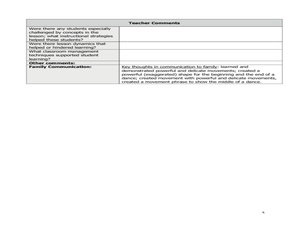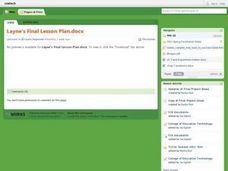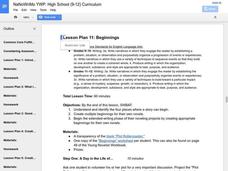Student Handouts
Beginning-Middle-End Chart
Track the plot of a book with a straightforward chart. Pupils write in the title of the book and then note down what happened at the beginning, middle, and end of the story.
Curated OER
Publishing Stories: Beginning, Middle, End
First and second graders explore the importance of having a beginning, middle, and end when writing stories. In this story writing instructional activity, students write short stories using the story diamond as a guide. They invite their...
Curated OER
Beginning Middle And End
In this Language Arts worksheet, students read a story. Students write the title and describe the story's beginning, middle, and end.
Curated OER
The Beginning, The Middle, & The End
Cut magazine pictures into three sections, having your youngsters piece the pictures back together. With this fun activity, they discover the importance of sequencing a story. Then they use a fun template (shaped like a burger) to write...
Curated OER
Story Stick Medallions
Students identify and visually represent important events in the beginning, middle, and end of a story. They arrange the pictures in sequential order. Students verbalize details while they retell their story idea to friends and family...
Curated OER
Crater Creation
After looking at the back of a quarter featuring Oregon terrain, learners distinguish between fiction and non-fiction and identify the beginning, middle and end of a story. First, they listen to legends that describe the creation of...
Curated OER
What is a Philanthropist?
What does a philanthropist do? Help your class explore philanthropy using character development and literacy ideas. Learners will define and give examples of philanthropy, listen to The Lion and the Mouse, discuss how the characters help...
Curated OER
Beginning, Middle, and End
First graders identify the beginning, middle, and ending of a story and describe the plot, setting, and the characters. As a class they read a picture story and identify the beginning, middle, and end. Students then draw a picture of...
Curated OER
Martin Luther King Jr.
After listening to a story about Martin Luther King Jr., first graders answer questions about the text. They discuss the importance of the illustrations, identify the beginning, middle, and end of the story, and complete a writing...
Curated OER
Dance and Writing
Fourth graders use dance moves to perform narratives. In this dramatic performing lesson, 4th graders use strong and soft movements to show what character's voice is portraying. Students also use movement to show the feelings in the...
Curated OER
Beginning, Middle, Ending of Story
In this retelling a story in order worksheet, students write short answers for the beginning, middle and end of a story of their choice. Students compete three parts of the worksheet.
Curated OER
Reading Made Easy with Mindwing Concepts
While this resource is actually attempting to sell a product, the foundational ideas may be worth looking into. Using Braidy the StoryBraid doll, learners will gain a better understanding of beginning, middle, and end, as well as story...
Curated OER
"The Three Billy Goats Gruff:" Retelling the Story
Youngsters retell the story of The Three Billy Goats Gruff. They write a sentence for speech bubbles for a character in the story, identify the phrases that can be used for retelling a story, and in small groups write a sentence for the...
Curated OER
Where Do We Begin?
Primary learners grasp sequence of events by discussing morning routines and reviewing the story of Little Red Riding Hood. They explore the necessity of correct order of events. As a class, create a story with a beginning, middle, and...
Hawaiʻi State Department of Education
Story Design
Stories contain very specific elements; plot, characters, and key events. Learners use pantomime to retell a key event from the beginning, middle, and end of a story. They discuss setting and character as each group discusses and then...
Curated OER
Printable Story Starter: The Get-Away
This fun, creative writing prompt invites young writers to continue the story of Boe and Tim, who discover a hot air balloon while escaping from their big sisters. The worksheet provides a space where learners can finish the middle and...
Curated OER
Sequencing in Reading
Third graders explore language arts by analyzing a children's story in class. In this story structure lesson, 3rd graders read the book The True Story of the Three Little Pigs and write a brief summary. Students identify the beginning,...
Curated OER
Elmer by David McKee
Young scholars explore individual differences. In this literacy and self-esteem lesson, students listen to the story Elmo by David McKee, then describe what characteristics make Elmo special. Young scholars complete a T chart showing how...
Curated OER
Animation Pre-Production
Does your class love reading cartoons? Use their talents and interests to examine the process of writing a story they wish to tell through a cartoon. They develop the beginning, middle, and end of a story based on their original...
Curated OER
Telling a Story
Students create a story about a picture. In this writing lesson plan, students select a picture and write a story about what happened in the picture. Students are encouraged to write a story with a beginning, middle, and end.
Curated OER
Sequencing: Beginning, Middle, End
In this sequencing worksheet, students draw 3 pictures, showing the beginning, middle and end of a stories about making pizza and getting ready for school.
Curated OER
Lesson Plan 11: Beginnings
Every good novel needs a solid beginning! Setting the stage can have your budding authors stumped, so use this lesson to get them thinking. After examining the plot rollercoaster image (included) they consider the four places...
Curated OER
Build Mastery: Sequencing
Writing a summary is much easier once you've laid out the sequence of events. Show readers how these two skills are intertwined using this graphic organizer. Review the meaning of sequencing first, presenting the chart and possibly...
Curated OER
The Memory Invention
Young writers edit their writing to make sure it shows good meaning and clarity. In this writing instructional activity, students are given a variety of "What If?" scenarios to choose from as writing prompts. A class discussion ensues,...























